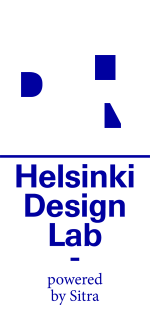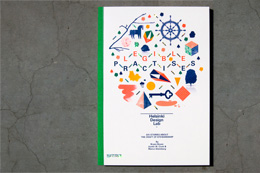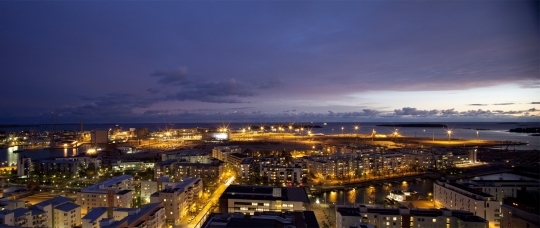Helsinki Design Lab helps government leaders see the "architecture of problems." We assist decision-makers to view challenges from a big-picture perspective, and provide guidance toward more complete solutions that consider all aspects of a problem. Our mission is to advance this way of working—we call it strategic design.
This momentous week (100!) passed as a flurry of early-stage discussions on emerging areas of work in Sitra Strategic Design land.
Three of the many plates spinning, offered with little or no context:
Right now we're interested in food culture in Finland's major cities, and especially street food. This means we've been thinking about Grillis, Snakkeris, and Kahvilas. Olli from the Sitra's Energy Programme has been drafted to help Justin and I bite into this new topic.
It's still surprising how much interita simple terms can posess, and similarly how freeing it can be to rephrase known terms in new words. As the Strategic Design Unit begins working on project with two other programmes in-house, we're devoting a lot of effort to figuring out how the internal collaboration should work, and the basic vocabulary that we all use is first on the list.
Marco is working with the Synergize Finland team to bring the HDL Studio model to one of their projects this spring. Whereas with HDL we ran three studios in sequence last summer, the Synergize team are going to do three at the same time. We're curious to see how this creates new potentials and new stress points. It's always nice to work with another team because it the process of sharing forces us to be more articulate about what we do and how we do it. This adds a welcome level of rigor.

Week 100: this is what traction feels like.
Two years into the HDL reboot, 71 weeks since our first weeknote, and 2.5 years into strategic design at Sitra. Here's to many more!
Here in the strategic design corner of Sitra we continue to noodle on a collection of related topics that have been stewing since last fall.
The topics in play during thse last weeks have now bubbled up at different times during the evolution of HDL. We're in the middle of fleshing out the documentation of the HDL Studio in an attempt to describe it as a model that may be useful to others. There's also an increasingly apparent lack of a strong strategic design literature, or even a single regular publication that covers strategic design. Our case studies are not enough! And as always, the difficulties that offices experience in building a practice around strategic design still persist, even in a design market as developed as Finland.
These categories loosely map to the triad of knowledge (available approaches), capability (available business models), and achievement (success stories) that we identified as key targets when we crafted the first HDL mission statement one year ago. Our activities in 2010 were weighted towards developing and testing the studio model, so we have some activity on development of useful knowledge. We also dedicated a lot of time and effort into getting out to meet people and see who is acting in this space and learn what their experiences have been.
Now in 2011 we're tilting a bit towards fostering capabilities, both internally within Sitra as well as within Finland more broadly, and thinking about ways to share and communicate the achievements of the entire strategic design community.

A view across the water to Jätkäsaari. 2011-2012 will see big changes here.
Elsewhere in strategic design at Sitra, the Low2No team held a day-long seminar 'opening the books' on the development of Sitra's block in Jätkäsaari. Not a lot of questions were asked after each presentation, but there was lively chatter during the coffee breaks. That's when people ask the tough questions anyways, so we were happy. Design work continues on that project with an impressive international collaboration spanning between Finland, the UK, Germany, Italy, the US, and Australia.
Meanwhile, Justin and I are taking a moment to focus on architecture. Thanks to the kind invitation from a respected journal of architecture in the US, we're taking a stab at applying the precepts of strategic design to the practice of architecture. With reflections from the Low2No process and our other work, combined with our individual backgrounds in architecture, it's a gratifying challenge to develop a meaningful criticism of architecture as it is typically practiced while using what we've learned about the possibility of a strategic design role to point at future possibilities. What do new models of architecture practice look like in that area?
Kevin Slavin's talk at Lift '11 brings up the question of new models of practice through a brilliant exploration of the role of algorithms in contemporary life, and especially in financial markets. Slavin discusses the role of genetic algorithms in contemporary computation and highlights the critical difference that these algorithms have self-learning capabilities which allow them to "write things [that] we can't read anymore." The 'Flash Crash' of the New York Stock Exchange last May is a very palpable example of how much impact these un-readable writings can have.

A long-exposure photograph showing the human-recognizable path used by a Neato Robotics XV-11 to clean a room (Photo: Gearfuse)
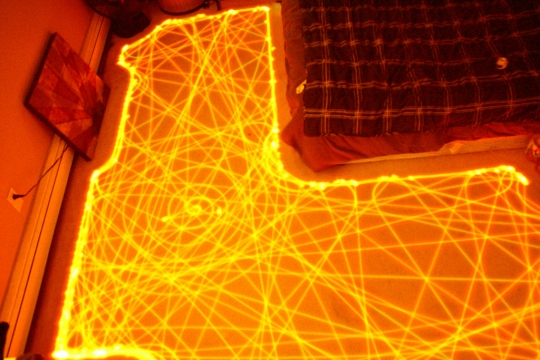
The cleaning path of a Roomba (Photo: Signaltheorist)
Kevin illustrates this in another way by showing two exmaples of pathways used by floor-cleaning robots. One follows a familiar logic of cleaning around the edges while the other appears random and chaotic to human eyes, yet it's intensely calculated and intentional. As we are increasingly forced to confront the wicked nature of some problems before us, I'm expecting that we will find ourselves developing solutions that look more like the Roomba and less like the Neato. In other words, when designing for the unpredictable, we should not be surprised to arrive at the unexpected.
Calendaring and planning work continue here in the strategic design corner of Sitra as we start to lock into place commitments for our various projects this year. One of our focuses is 2011 is beginning to transfer some of our findings in strategic design methods, ability, and content to our fellow teams at Sitra. This means we're spending a lot of time in the elevator buzzing from floor to floor visting people in the Energy, Landmarks, and Public Leadership programmes as well as our communications team. Doing this has spurred much self reflection as we try to articulate how we work and be more specific about what the tools are and when they are best utilized.
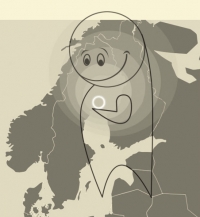
The students asked if Umeå can be the capital of the Top of Europe across the Nordic region
What seems like endless planning and prep is now beginning to gel (really!) and Marco will chime in soon with an update about strategic design's role at Sitra, but until then we're happy to direct you to the full dossier of our studio with Umeå Institute of Design that we mentioned last week. The students did a great job or having zero experience with strategic research and analysis, let alone merging that with their design background. Have a look at the Growing Västerbotten dossier.
We've also begun a number of writing projects including a couple articles for publications here and there, as well as a summary of the HDL Studios we conducted in 2010. More on this soon. Good night, week 97!
We're back from a week (#96) in Umeå, Sweden, home to the Umeå Institute of Design, and location of a courageous experiment in Prototyping the Future. Anna Valtonen, HDL Global 2010 participant and Rector of the school, decided to shut the place down for a week to pause and consider what the future of the design school may be. All students, staff, and even Anna herself put aside their course work to participate in special workshops taught by guest faculty. Marco, Justin, and myself brought the HDL Studio model to Umeå as an example of how designers might begin to play more strategic roles, especially in service to government.

Västerbotten is about the same size as Denmark but has only 1/16th the population.
To demonstrate this concept we teamed up with the county government of Västerbotten, the second largest county in Sweden and administrative region that includes the city of Umeå. Governor Chris Heister and Deputy Governor Birgitta Heijer issued a challenge: How can we make Västerbotten more attractive so that it attracts new residents and retains existing ones?
We asked the students to develop ways to rethink traditionally difficult aspects like the far northern location of Västerbotten as assets that could be utilized to develop a new vision for the county. Governor Heister described the unofficial slogan of the county as "In Västerbotten we have it all" which the studio flipped around to be "In Västerbotten you can have it all!" This highlights the county as a place of opportunity that benefits from diverse natural environments, geographies, urban densities, and lifestyles, where it's easy and comparatively cheap to take root.
The Governor issued the challenge, Sitra brought the HDL Studio model and played the role of facilitator, and UID students did the hard work. It was a hectic week, but a good one. We certainly learned a lot about what makes a studio tick and this is invaluable knowledge as we continue to hone the HDL Studio model.

A snapshot from the final presentation
The students had a tall order ahead of them. With only five days to deliver they had to dive into new territories such as economics, public policy, and demographics; make sense of this tangled mess of perspectives; and propose a framework for developing a course of action for the county.
The presentation went well and sparked a lively discussion with the Governor and her guests. While the students are gathering up their presentation material I'll leave you with a cliff hanger, but as soon as the files materialize we'll prepare a dossier of the week. In the meantime, there are a pile of pictures up on Flickr.
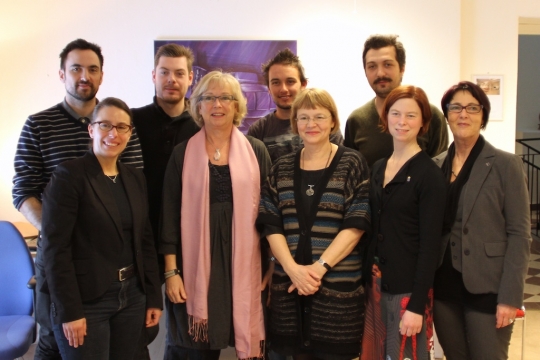
The studio with Governor Heister and her guests
Week 95 was spent in London catching up with some other HDL Global 2010 participants in between meetings related to other Sitra business. It was especially great to catch up with Indy Johar of Research 00 Architecture as well as our friends at the Young Foundation.
First and foremost, we want to wish everyone a happy new year. 2011. 2011!
We ended the year with a bit of chaos. We're putting the finishing touches on our work plans for the next phase of strategic design at Sitra and Helsinki Design Lab. It has taken longer then expected, but it finally seems as though the end is in sight.

Brasilia is a stunning capital designed as an automotive-utopia.
Just before Christmas Marco was off to Moscow, while I was in Brazil to present our work at the Foresight International Seminar hosted by CGEE, a Sitra-like organization in the Brazilian context. I was presenting to a group with various backgrounds in foresight, forecasting, and futures. Not being terribly familiar with that discourse, it was interesting for me personally to learn some new things—OK, a lot of new things—as well as to see some new opportunities for the strategic design approach we've been developing at Sitra.
The conversation touched on many similar points: how do you measure ambiguous efforts? How do you convince people to invest upfront in work that will pay big dividends later? And whereas many of the foresight presentations were incredibly rigorous in their application of quantitative methods to back up their assertions, as a group we struggled with the question of balance between rigor and speed.
One question I took away from the event is whether strategic design, and specifically the HDL studio model, can achieve this balance between rigor and speed. As we look out across the vast expanse of 2011 and think about the work we will do this year, one of our goals is to test the studio model in different contexts. We begin in a couple weeks with an experiment in Umeå at the Institute of Design. Details from that in a few weeks.
Helsinki is under a heavy blanket of snow which has added a lovely bit of chaos to the streets. We're happy to accept the occasionally frightening skid-stop of a lumbering bus if the weather also brings with it amplified levels of daylight reflecting off the ground cover.
Last week Marco was in Brussels sharing HDL's work at the Design and Learning conference. I was away in Madrid doing the same with a group of innovation researchers sponsored by the Spanish National Research Council. The participants were a mix of academic and professionals which resulted in some productive friction as we adjusted to the language and concerns of our peers. I was particularly interested in Steve Flowers' work on defining different categories of user-led innovation. So often this term is treated as a homogenous lump of stuff, but Flowers breaks it down into five different levels of involvement that scale up in their innovation potential.
- Users provide feedback
- Users produce content for existing products
- Novel use of existing products
- Modification of existing products
- Creation of novel products
As he pointed out, not all user innovation is bound for the market. Sometimes (a lot of the time?) innovation, user-led or not, produces weird results. Such as a disused MiG mounted on a train used to clear snow off of train tracks.
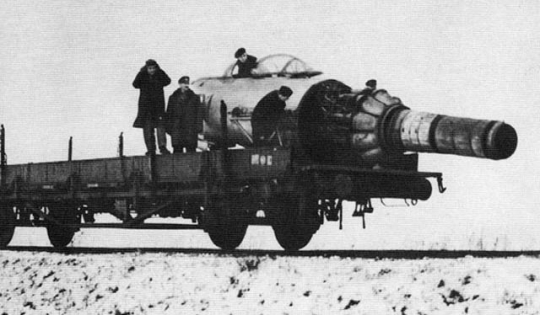
Image borrowed from this collection of truck-mounted jet engines.
Drew Hemment shared his work on the FutureEverything festival which he sees as a vehicle for social innovation. The broad range of activities they're conducting is too much to go into here but it includes bubble races (PDF) used to measure urban heat island affects. Drew gave us a peek at an almanac of sorts which FutureEverything is now working on to share their methods with others looking to do something similar. It's encouraging to see such an open sharing of experience. We try to do the same thing with our How-Tos.
Meanwhile, Justin was in Germany with part of the Low2No team. He's been keeping weeknotes over at the Low2No site and I highly recommend reading them for the full scoop on how that project is coming along.
I'll close this update with a hearty congratulations to the SIX Social Innovation Exchange for their successful bid to create and EC-sponsored Social Innovation Initiative for Europe. HDL is happy to be part of the advisory board for this project and we look forward to being part of it.
The fact that this weeknote is a triple edition is testament to the fact that we are ending the year at a steady clip.
Week 086 was mostly spent in Israel, where Justin and I were on site to visit the Alexander River Restoration project. As a cross border, cross disciplinary collaboration that has been delivering successful results for more than a decade, the project is an exciting one for groups like HDL who are interested in how to work on large scale challenges.
Justin and I will be in 'bubble mode' writing this case in the coming weeks to have it up on the site here before the end of the year. That will make four cases in the first nine months of this website's existence. Not as many as we had hoped, but we hope it's enough to start outlining a particular idea about what design is capable of. Onwards!
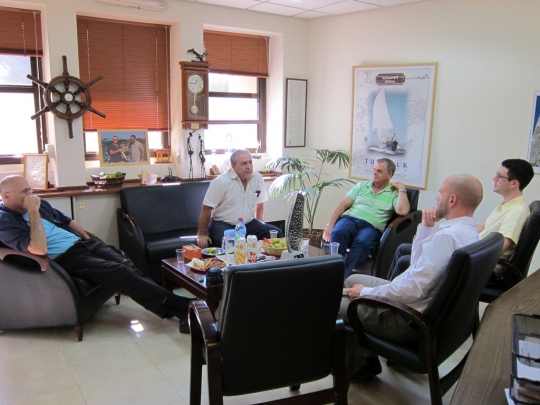
A visit with the Mayor and Deputy Mayor of Emek Hefer Regional Council, and CEO, Sharon Drainage Authority.
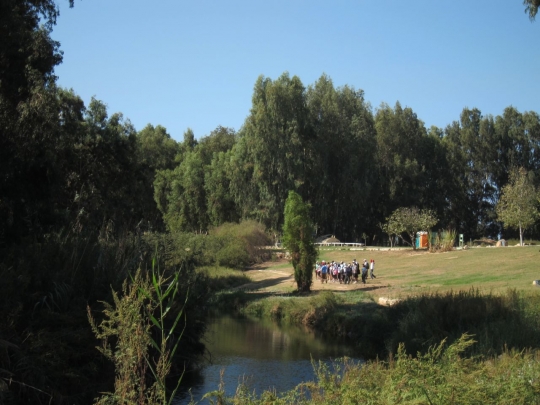
The lush Alexander River, now enjoyed by visitors from all over Israel, used to be a sewage canal.
087 and 088 have been spent revisiting collaborators from the HDL Studios, Global event, and our other activities to gain a bit of perspective through peer evaluation. It's part of a larger task of figuring out what worked well and what needs to be rethought. Always nice to hear feedback, especially when you have such smart peers.
When he was in town last week Patrick pointed us to an article in the Economist discussing Obama's Social Innovation Fund which launched this summer. Although small money from the perspective of the US government, 50 million USD is a substantial vote of confidence for the social innovation community. The Obama initiative is aimed at ramping up existing projects, a necessary tool as members of the SI community attempt to prove the viability of their methods at scale.
Obama's fund has a lot of potential to enable groups delivering new efficiencies in situations where a problem is known but not well solved. Solution X, a better alternative comes along, so let's find a way to make sure Solution X has the capital it needs to get started. This includes privatization with an emphasis on competition and new social ventures positioned between the market and 3rd sectors, in effect augmenting both (think microfinance or the Omidyar Network).
But what about those situations where the problem itself is unclear? This is the context of systemic failures—all parts might be functioning very well, but they're not sufficiently coordinated as a group. The glue is missing, and maybe some key parts too. The American healthcare system (if it could be called that) is a prime example of this.
To create strategic impact in these areas there are three critical dimensions which need to be addressed.
- Team: problems that exist at the intersection of multiple areas of interest always require teams of multiple expertise.
- Money: good will only lasts so long.
- Legal and regulatory support: Stephen Goldsmith, now chairman of the group that oversees the Social Innovation Fund, hit the nail on the head: “I can think of 1,000 innovations. I have not yet had an innovative idea in any meeting that was legal.”
To work on those kinds of problems a different approach is needed because they are 'pre-market.'
This is kind of thing that our brains are churning on these days.
Our mind has been on investments this week. Monday started off at full clip with Patrick and Kipper from Social Investors Partners visiting Sitra, and we ended the week with David Wood from the Institute for Responsible Investment here to contribute to Low2No.
Through a conversation that has grown during the past couple months, Social Investors Partners has been helping us think through some of the current barriers to strategic design particularly from a funding perspective. At the moment this is just a collaborative brainstorm but we're hoping to be able to turn it into something more in the near future. We'll keep you posted.
In the meantime, I highly recommend checking out Social Investors Partners' new website, especially the succinct success stories which tell the story of their work for foundations and philanthropists looking to put their money to work for the common good.

Christophe Vorlet for The Chronicle
Elsewhere, Marco has an article about the fate of universities and the potential of design in the Chronicle of Higher Education.
Justin has been here in Helsinki for the week, working with the Low2No team. He and I depart to Tel Aviv this weekend where we will be making a case study visit to Amos Brandeis and the Alexander River Restoration Administration. We're looking forward to learning first hand from their ecological restoration work which has been guided by strong multidisciplinary collaboration over the last twenty years. Great stuff.
The case study library has not grown as rapidly as we had initially hoped, but in a way this has been a nice reality check. With a grand total of zero submissions since we launched this site earlier in the year, we now realize that there are very few projects out there which are exemplary strategic design efforts. I'm optimistic that this will change!
A quick post for a quick week. We were strewn about again. Marco was in London presenting at the European Future Energy Forum and Justin and I were in Boston charretting on Low2No.
It's always nice to hear other people's thoughts about our work, which is why I enjoyed Thomas Lockwood's post at the Fast Company Design blog reflecting on his time at HDL Global 2010. Thomas runs DMI, whose annual Design Management Conference starts today.
Boston is as gray as Helsinki this time of year. The lack of dissonance between their skies is actually more odd to adjust to than if both cities were distinct.
Speaking of weather, the results from last week's photo shoot are back and they look stellar. Here's a sneak peek:
This week we particularly enjoyed an 'op-chart' in the New York Times depicting strategic changes to a high school lunch line that resulted in healthier eating habits. Here's the key line from an article in another paper:
How much... would a school need to cut its prices for apples, oranges and bananas to increase sales by 5 percent over a year?
Brian Wansink was called in to play detective. But... soon discovered he had been hired to answer the wrong question. Price wasn't the problem. It was the presentation.
By making small tweaks such as changing the order that food items are presented in, offering more descriptive names, and changing the containers that food is kept in, Wansink and his team were able to effect positive change in the diet of those who used their test cafeteria. The interactive illustration in the Times is great, check it out.
